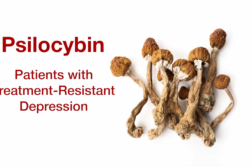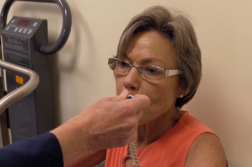ORLANDO, Fla. (Ivanhoe Newswire) — The statistics are scary. The number of kids requiring hospital treatment each year for physical assault-related injuries can fill every seat in nine stadiums. And 19 percent of those injured kids have post-traumatic-stress disorder. For some kids the traumatic stress is short-term. For others, it has a long-term impact.
It happens more than you think.
Michael Scheeringa, MD, Professor of Psychiatry at Tulane University told Ivanhoe, “There have been studies that show by the age of 16, two-thirds of youths in the United States are going to be exposed to at least one life-threatening, traumatic event.”
But how can parents spot the signs of trauma? First, know the difference between a stressful event versus a traumatic one. A traumatic event is …
“Life-threatening things; these are usually sudden, unexpected moments of sheer panic for your life,” explained Dr. Scheeringa.
These can include physical abuse, sexual abuse, witnessing domestic violence and even car accidents.
Dr. Scheeringa said, “For very young children that can be attacks by dogs.”
Next, spot the signs. Trauma in kids varies by age. Kids under five tend to cling to parents and may return to behaviors common to when they were younger, like thumb sucking or bedwetting. Children six to eleven may develop unfounded fears or lose interest in friends and family. Finally teens may avoid reminders of the event and abuse alcohol and drugs. The sooner a parent can identify the signs, the sooner the child can get treatment and then the child’s life can return to normal.
Your child didn’t have to necessarily be part of the traumatic event to suffer trauma. Repeatedly viewing video clips on social media or news sites can still have a traumatic effect on kids.
Contributors to this news report include: Milvionne Chery, Field Producer and Roque Correa, Editor.
Free weekly e-mail on Medical Breakthroughs from Ivanhoe. To sign up: http://www.ivanhoe.com/ftk
KIDS AND TRAUMA: WHAT TO LOOK FOR
REPORT #2564
BACKGROUND: More than 25 percent of American youth experience a serious traumatic event by their 16th
birthday, and many children suffer multiple and repeated traumas. Common sources of trauma include child abuse and neglect; serious accidental injury; disasters and terrorism; experiencing or witnessing violence in neighborhoods, schools and homes; and treatment for life-threatening illness (medical trauma). After a crisis or traumatic event, a child is at risk of developing traumatic stress. About 25 percent of victims and witnesses of violence develop PTSD, depression or anxiety disorders. Children are more vulnerable to trauma because of their size, age, and dependence. Prior trauma, past mental health problems, or a family history of such problems may also increase a child’s risk.
(Source: https://www.melissainstitute.org/documents/ChildTraumaBasicFacts.pdf)
RECOGNIZING THE SIGNS: Signs of traumatic stress include fear, anger, withdrawal, trouble concentrating, digestive problems, and nightmares. Behavior disorders and “acting-out” can also be symptoms of trauma. Academic failure, higher rates of absenteeism, expulsion and suspension are associated with students’ exposure to community violence. A child’s distress may not be obvious or visible. By talking with them you may discover that they are experiencing traumatic stress. They may be re-experiencing the
trauma through images, thoughts and feelings. They may try to avoid people and places that are traumatic reminders. They may seem numb because they are trying to avoid feeling their own feelings. Serious, ongoing traumatic stress reactions that include intrusive thoughts and images, strong emotional and physical reactions to reminders of the trauma, avoidance, and a sense of “being on alert” are hallmarks of traumatic stress. If symptoms persist after 60 days, an evaluation for Post-traumatic Stress Disorder (PTSD) is recommended.
(Source: https://www.melissainstitute.org/documents/ChildTraumaBasicFacts.pdf)
CHILDHOOD TRAUMA LINKED TO ILLNESSES: Severe trauma and exposure to large amounts of stress in childhood is linked to epigenetic changes, or changes in the way that the body turns genes on and off and regulates biological processes that can last into adulthood. Studies show differences in the activity levels of hundreds of genes between people who experienced trauma in their childhood and those who did not. While scientists don’t know how all of those changes affect health, there’s good evidence for the function of a few. Most research has focused on changes to genes involved with the receptors that regulate the stress hormone, cortisol. The changes in those genes, noted in both human and rodent studies, cause cortisol levels to stay elevated for longer during stressful events, and make it harder for the body to relax. Kerry Ressler, chief scientific officer and James and Patricia Poitras Chair in Psychiatry at McLean Hospital in Massachusetts, says, “Childhood trauma, then, reshapes how the body responds to stress long-term, across the lifetime.” That deregulation of the healthy stress pathways leaves people at risk for depression and other psychiatric disorders. Cortisol is also involved in the immune system, so epigenetic changes to its normal function leave people more vulnerable to illness throughout their lives. That may contribute to the increased risk of heart disease, cancer, and other adult illnesses in people who experience childhood trauma.
(Source: https://www.popsci.com/childhood-trauma-epigenetic)
* For More Information, Contact:
Keith Brannon, Associate Director
Tulane University Public Relations
504-862-8789



